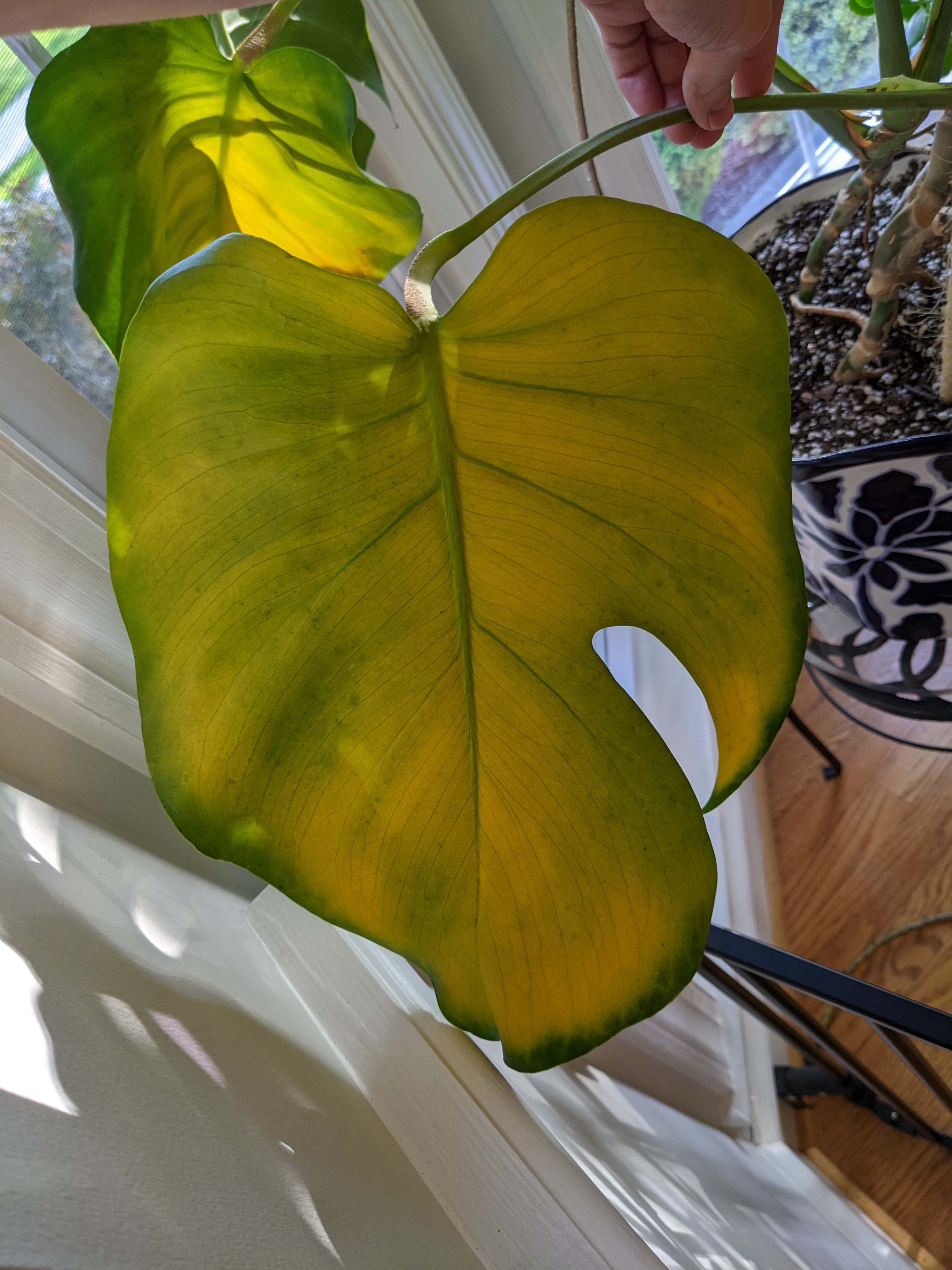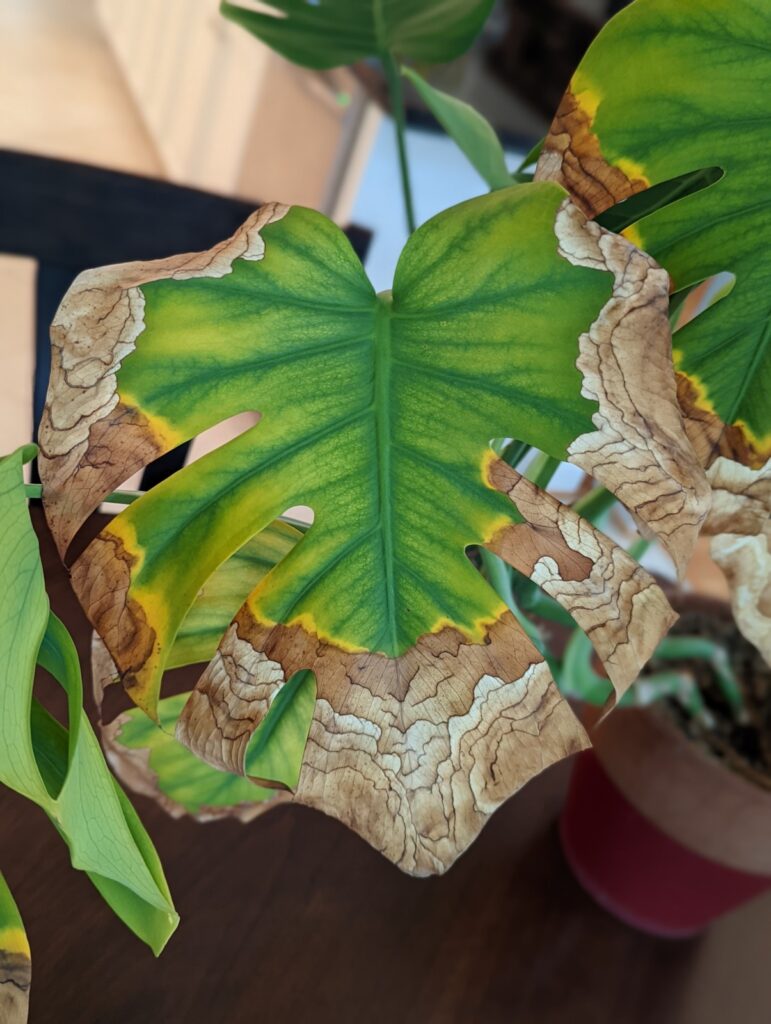Diagnosing Monstera Leaf Problems
Monstera Deliciosas are known for their large leaves. Their leaves have ornamental splits in them that are called fenestration. Since the leaves are really the showcase of these plants, it can be really concerning when you have Monstera leaf problems. This post will cover some common leaf problems and how to address them.
Common Causes of Monstera Leaf Problems
Moisture Issues Can Cause Leaf Problems
An abundance of moisture can cause leaf problems. Overwatering is when you either water too heavily or too frequently to the point that the soil is never waterlogged and never has a chance to dry up. Soil that is too moist will sometimes cause the roots to begin to rot and become diseased. Some signs of overwatering are leaves that are yellowing and browning, leaves that are wilting, or leaves that have black spots on them.

Having soil that is too dry can also cause leaf problems. Ideally, you want to let the first inch or two of soil in your Monstera's pot to dry in between waterings. Some people check soil moisture with their finger to see if it has dried two inches. That can be a little hard to do with Monsteras because their roots are very thick and aggressive to the point it can be difficult to even get your fingers in the soil two inches. To me, the most reliable way to tell if there are water issues is to use a soil moisture meter. A simple tool like this soil moisture meter will do the trick. Underwatered Monstera leaves may also turn yellow. Underwatering often affects older leaves first, so if you see several of your lower leaves begin to turn yellow, then it could be an underwatering.
How to Fix Moisture Issues
Fixing underwatering issues is pretty straightforward. You either need to water more often or more deeply. I would also recommend monitoring your soil's moisture more closely so you know how long it takes for your Monstera to dry out. I want to say for clarity though that just because a lower leaf turns yellow, does not automatically mean your plant is underwatered. In fact, it can be completely normal for a single older leaf to eventually yellow and fall off.

Once you start watering more frequently or more deeply, make sure that the water doesn't just run through your plant. Sometimes soil that has been really underwatered can become hydrophobic. If that happens, you may need to water from the bottom. To do that you just need to stick your plant pot in a bowl or the sink with water and let the soil and roots soak up water from the base of the plant.
Things get more complicated if you have overwatered. First, you must gently remove your Monstera from its pot. This helps you do two things: 1) It will let the root ball and soil dry out more quickly. 2) Inspect the roots for rot and disease. Overwatered roots are very susceptible to disease and even physical damage, you must make sure you're careful and clean when inspecting the roots. I recommend letting the root ball dry enough to where you can handle it. When you're inspecting you want o lookout for rotten roots. They will appear brown and feel mushy. They may also smell. If you find rotten roots you need to cut them away with something clean and sharp. Then you can repot your Monstera in new soil and hope for the best. I have a whole post dedicated to fixing an overwatered plant if you want to follow along in more detail.
Fertilizing Issues Can Cause Leaf Problems
Nutrients are the same as moisture you can both over and under-fertilize. Yellow leaves are generally a sign of under-fertilization. An overfertilized Monstera is more likely to exhibit slow growth and maybe wilting. It's unfortunate that many people will incorrectly assume that slow growth or wilting leaves is reason they need to fertilize more, Typical houseplant fertilizers have a balanced ratio of nitrogen, phosphorous, and potassium, or n-p-k, which you see on the label of the plant fertilizer. Yellow leaves may be a symptom of a lack of nitrogen or potassium. Nitrogen helps promote healthy foliage growth and potassium is for overall plant health.
Like underwatering, under-fertilization may affect the lowest leaves first but you'll often see signs in a lot of leaves. Underfertilization can show up as yellowing leaves. Diagnosing a nutrient issue can be difficult. I use soil rapitest which allows you to test for ph and each nutrient individually. It's the only way to be totally sure you have a nutrient deficiency or abundance. If you have a lot of plants, it's a good investment.
How to Fix Fertilization Issues
If you have overfertilized your Monstera, your best bet is to flush the soil by watering it a lot. You could even remove it from its pot to let the water flow through more readily. It will also let the soil dry out faster because you don't want to end up overwatering an already overfertilized plant.
To fix an under-fertilized plant you just need to fertilize it. Water-soluble fertilizers work best for quicker absorption. In most cases, you'll just want to stick with a balanced fertilizer. That means that thenumbers of the n-p-k ratio on the package are the same or really close in value. They do also make fertilizers that are heavier in one nutrient. I don't recommend getting a non-balanced fertilizer without first taking a soil rapitest. In addition, be sure to follow the instructions on the fertilizing product. Some fertilizers require dilution or that you water the plant beforehand.
Pests Can Cause Leaf Problems
Monsteras can be afflicted by many types of plant pests. Most pests attack foliage, causing leaf yellowing that will most likely appear in a spotted or splotchy pattern. Aphids, scale/mealybugs, spider mites, and thrips are the most common houseplant pests. These pests feast on leaves which will ultimately destroy them. It's important to do a close visual inspection of your plant as soon as you can. Use a flashlight to help you see contrast and shadows (or webs if you have spider mites). Pay close attention to the underside of the leaves and where new leaves are growing, those are popular spots for pests.
How to Fix Pest Issues
It is essential that you move any infested plant away from other healthy plants as soon as possible. These pests are extremely good at migrating from one plant to another. Eradicating pests takes many steps. First, remove as many pests as possible. You can wipe them off, spray them off with a strong stream of water (in the shower or with a hose), or manually pick them off. Scale and mealybugs require manual removal because they have an armor-like shell.
Next use an insecticide. There are organic versions like neem oil. I have used neem oil on spider mites that had infested one of my Rubber Plants successfully. Nonorganic insecticidal soap also works on these pests. After you do this continue to monitor your plants for a week while it's still quarantined. Sometimes eggs remain and new pests hatch after you think they're all gone. You don't want to deal with a reinfestation.
Hopefully, this helps you identify your Monstera leaf problems and now you can begin your journey toward fixing it. Have any questions? Post them in the Comments section below.
Add new comment